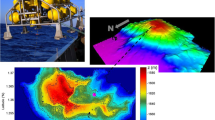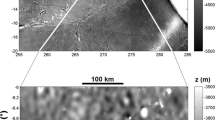Abstract
The kilometer-long sub-surface mooring ‘KmT’, densely instrumented with 760 high-resolution temperature ‘T-’sensors, demonstrates details of turbulent mixing in the vicinity of a large seamount. Away from the internal wave breaking zone above the seafloor, turbulence is observed in two cases. It is found in thin layers along isopycnals providing non-smooth dispersal, as well as induced by internal wave breaking following strongly non-linear interaction as in a hydraulic jump more than 500 m above the local seafloor. Turbulence levels for these cases are relatively low and high, respectively, but always one to two orders of magnitude larger than in the ocean interior far from topography. Both cases imply the importance of underwater topography like a seamount for deep-sea turbulence. The seamount functions as a lens focusing internal waves into a turbulence-generator.











Similar content being viewed by others
Data availability
Data will be made available on reasonable request.
References
Alford MH, Pinkel R (2000) Overturning in the thermocline: the context of ocean mixing. J Phys Oceanogr 30:805–832
Armi L (1978) Some evidence for boundary mixing in the deep ocean. J Geophys Res 83:1971–1979
Armi L (1979) Effects of variations in eddy diffusivity on property distributions in the oceans. J Mar Res 37:515–530
Bolgiano R (1959) Turbulent spectra in a stably stratified atmosphere. J Geophys Res 64:2226–2229
Cacchione DA, Drake DE (1986) Nepheloid layers and internal waves over continental shelves and slopes. Geo-Mar Lett 16:147–152
Dale AC, Levine MD, Barth JA, Austin JA (2006) A dye tracer reveals cross-shelf dispersion and interleaving on the Oregon shelf. Geophys Res Lett 33:L03604. https://doi.org/10.1029/2005GL024959
Dillon TM (1982) Vertical overturns: a comparison of Thorpe and Ozmidov length scales. J Geophys Res 87:9601–9613
Gregg MC, D’Asaro EA, Riley JJ, Kunze E (2018) Mixing efficiency in the ocean. Ann Rev Mar Sci 10:443–473
Hebert D, Oakey N, Ruddick B (1990) Evolution of a mediterranean salt lens: scalar properties. J Phys Oceanogr 20:1468–1483
Holtermann PL, Prien R, Naumann M, Mohrholz V, Umlauf L (2017) Deepwater dynamics and mixing processes during a major inflow event in the central Baltic Sea. J Geophys Res 122:6648–6667. https://doi.org/10.1002/2017JC013050
Hosegood P, van Haren H (2004) Near-bed solibores over the continental slope in the Faeroe-Shetland Channel. Deep-Sea Res II 51:2943–2971
Inall ME (2009) Internal wave induced dispersion and mixing on a sloping boundary. Geophys Res Lett 36:L05604. https://doi.org/10.1029/2008GL036849
IOC, SCOR, IAPSO (2010) The international thermodynamic equation of seawater – 2010: Calculation and use of thermodynamic properties. Intergovernmental Oceanographic Commission, Manuals and Guides No. 56, UNESCO
Klymak JM, Legg S, Alford MH, Buijsman M, Pinkel R, Nash JD (2012) The direct breaking of internal waves at steep topography. Oceanography 25:150–159
Lazier JRN (1973) Temporal changes in some fresh water temperature structures. J Phys Oceanogr 3:226–229
Legg S, Klymak J (2008) Internal hydraulic jumps and overturning generated by tidal flow over a tall steep ridge. J Phys Oceanogr 38:1949–1964
May BD, Kelley DE (2001) Growth and steady state stages of thermohaline intrusions in the Arctic Ocean. J Geophys Res 106:16783–16794
Marmorino GO, Brown WK, Morris WD (1987) Two-dimensional temperature structure in the C-SALT thermohaline staircase. Deep-Sea Res 34:1667–1676
Mayer FT, Fringer OB (2017) An unambiguous definition of the Froude number for lee waves in the deep ocean. J Fluid Mech 831:R3
Munk WH (1966) Abyssal recipes. Deep-Sea Res 13:707–730
Munk W, Wunsch C (1998) Abyssal recipes II: energy of tidal and wind mixing. Deep-Sea Res I 45:1977–2010
Nash JD, Alford MH, Kunze E, Martini K, Kelly S (2007) Hotspots of deep ocean mixing on the Oregon. Geophys Res Lett 34:L01605. https://doi.org/10.1029/2006GL028170
Nikurashin M, Ferrari R, Grisouard N, Polzin K (2014) The impact of finite-amplitude bottom topography on internal wave generation in the Southern Ocean. J Phys Oceanogr 44:2938–2950
Oakey NS (1982) Determination of the rate of dissipation of turbulent energy from simultaneous temperature and velocity shear microstructure measurements. J Phys Oceanogr 12:256–271
Osborn TR (1980) Estimates of the local rate of vertical diffusion from dissipation measurements. J Phys Oceanogr 10:83–89
Pawar SS, Arakeri JH (2016) Kinetic energy and scalar spectra in high Rayleigh number axially homogeneous buoyancy driven turbulence. Phys Fluids 28:065103
Phillips OM (1971) On spectra measured in an undulating layered medium. J Phys Oceanogr 1:1–6
Pingree RD, New AL (1991) Abyssal penetration and bottom reflection of internal tide energy in the Bay of Biscay. J Phys Oceanogr 21:28–39
Reid RO (1971) A special case of Phillips’ general theory of sampling statistics for a layered medium. J Phys Oceanogr 1:61–62
Ruddick B (1984) The life of a thermohaline intrusion. J Mar Res 42:831–852
Schmitt RW (1987) The Caribbean sheets and layers transects (C-SALT) program. Eos 68:57–60
Smith WHF, Sandwell DT (1997) Global seafloor topography from satellite altimetry and ship depth soundings. Science 277:1957–1962
Tennekes H, Lumley JL (1972) A first course in turbulence. The MIT Press
Thorpe SA (1977) Turbulence and mixing in a Scottish loch. Phil Trans Roy Soc Lond A 286:125–181
Thorpe SA, White M (1988) A deep intermediate nepheloid layer. Deep-Sea Res 35:1665–1671
Turner JS (1979) Buoyancy effects in fluids. Cambridge University Press, Cambridge
van Haren H (2018) Philosophy and application of high-resolution temperature sensors for stratified waters. Sensors 18:3184. https://doi.org/10.3390/s18103184
van Haren H (2019) Open-ocean interior moored sensor turbulence estimates, below a Meddy. Deep-Sea Res I 144:75–84
van Haren H, Gostiaux L (2012) Detailed internal wave mixing observed above a deep-ocean slope. J Mar Res 70:173–197
van Haren H, Cimatoribus AA, Gostiaux L (2015) Where large deep-ocean waves break. Geophys Res Lett 42:2351–2357. https://doi.org/10.1002/2015GL063329
Winters KB (2015) Tidally driven mixing and dissipation in the stratified boundary layer above steep submarine topography. Geophys Res Lett 42:7123–7130. https://doi.org/10.1002/2015GL064676
Woods JD (1968) Wave-induced shear instability in the summer thermocline. J Fluid Mech 32:791–800
Acknowledgements
I thank captain and crew of R/V Pelagia for their assistance and technicians of NIOZ-NMF for help in preparing and deploying the mooring. NIOZ-temperature sensors have been funded in part by the Netherlands Organization for the Advancement of Science (N.W.O.).
Funding
Aard- en Levenswetenschappen, Nederlandse Organisatie voor Wetenschappelijk Onderzoek.
Author information
Authors and Affiliations
Corresponding author
Ethics declarations
Conflict of interest
H.V.H. declares no conflict of interest.
Additional information
Publisher's Note
Springer Nature remains neutral with regard to jurisdictional claims in published maps and institutional affiliations.
Rights and permissions
Springer Nature or its licensor (e.g. a society or other partner) holds exclusive rights to this article under a publishing agreement with the author(s) or other rightsholder(s); author self-archiving of the accepted manuscript version of this article is solely governed by the terms of such publishing agreement and applicable law.
About this article
Cite this article
van Haren, H. KmT, detailing layered mixing governed by internal wave breaking. Environ Fluid Mech 23, 603–620 (2023). https://doi.org/10.1007/s10652-023-09921-5
Received:
Accepted:
Published:
Issue Date:
DOI: https://doi.org/10.1007/s10652-023-09921-5




